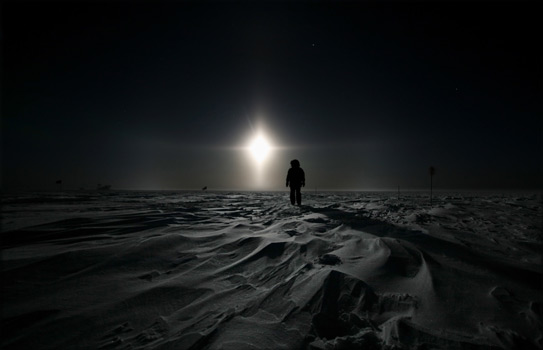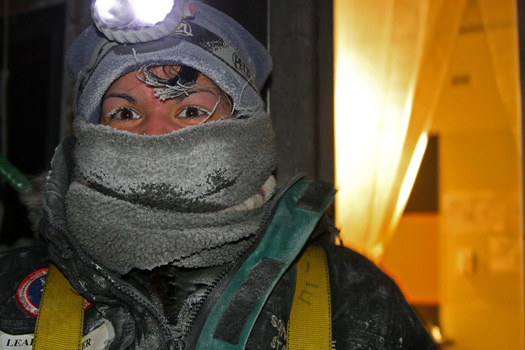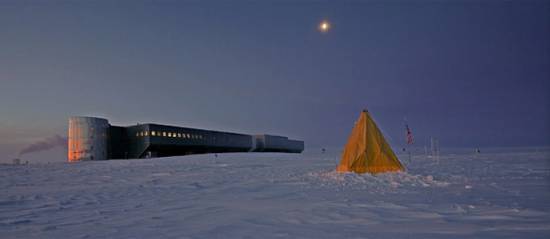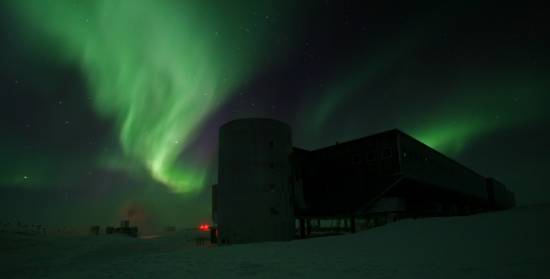Only the man who was in charge of the single lamp at the North Pole, and his colleague who was responsible for the single lamp at the South Pole, only these two would live free from toil and care: they would be busy only twice a year. —Antoine de Saint Exupéry, The Little Prince

The stars have been our companions for the past few months. Dancing in between them, the ribbons of the southern aurora offer light when the moon is gone. Watch them fade and the black grows so deep as to lose hands in front of faces, to discover wind drifts in the snow or a wall by blunt impact. The last remnants of the sun set in March, and the long dark has carried the sixty of us through the bitter winter of the South Pole.
All of Antarctica offers uniqueness in character of the land, the sky, and the sea. It’s a world as yet untamed, where it is still risky to do something as simple as stepping outside, or understand something so patterned as the rise and fall of the sun. Men of written history have found God and lost sanity here, have faced frostbite and harsh wind, fierce loneliness, silence and death. But in confronting this world, many of them also found tremendous beauty and great humility.
The last hundred years have tamed this continent somewhat, to a level that finds its safety concerns part of corporate databases, the warmer seasons attract thousands of visitors, and human impact grows every year. Yet in the midst of the growing hustle, a set of people gather, intent on experiencing that which only Antarctica can offer — the long night of winter.
From mid to late February through to mid October, Antarctica grows weary of visitors. Winds driving in from the polar plateau bring storms, gales, and extreme temperature drops. Travel not only within the continent but to and from it brings great risks. Temperatures descend into territory that render vehicles unusable, ice locks in summer harbors for tens if not hundreds of miles, planes cannot land in the cold and dark Antarctic winter, and survival without protection is measured in minutes. In response, the various stations close down, become isolated, and build upon an internal community to make it through the winter. When the last flight leaves, very few will see a new face for eight months. An entire existence becomes dependent on the equipment and people immediately around. In the event of any disaster, rescue, if possible at all, will be severely delayed.
Just over 900 people from a multitude of countries find this appealing each year. We’re split between 36 different stations, spread out over 4.5 million square miles. To some extent, every station experiences the Antarctic night. It is only at the very bottom of the Earth, eight hundred miles from our closest neighbor, that the South Pole bears witness to a single day spread out over an entire year. One sunrise and one long day; one sunset and one long, dark night.
The pursuit of science and the International Antarctic Treaty (one of the premier examples of international cooperation, preservation, and exploration) drive this continent’s development. Everything that is done here can relate back to furthering the knowledge of humankind.
Amundsen-Scott South Pole Station is an international hub, hosted by the United States Antarctic program. From a peak population of 300 in the summer months, who fly in and out from the coast, the isolated winter reduces that population to 60 or fewer.
We form a modern tribal community with the necessary skills between us to keep the station warm, powered, and gathering data until the return of the sun and the summer.
Scientists and technicians (known as “beakers”) manage an array of scientific acronyms designed to peel back the fog of the unknown. There are massive telescopes that look into the darkest sky on Earth, detector arrays that are buried kilometers deep in the ice below, gathering evidence of subatomic particles; digital eyes that seek out the streaming auroras; weather stations; atmospheric ozone devices; and sampling systems that gather the some of purest air on earth. The data pooled helps us to see and understand the very beginnings of the universe, to explore the relationship between the sun and the Earth’s magnetic field, and to provide a baseline for atmospheric comparison the world around.
To ensure the integrity of the data, a slew of men and women are responsible for maintaining everything from something as mundane as a clogged drain to the severity of a generator failure. Their skills keep us powered, warm, and alive. Chefs work miracles with frozen food (much of it years old) and supplement meals from the harvest in our greenhouse. A small IT department maintains the computer and server systems on station and keeps the limited, but vital, satellite and radio links to outside world, live. Carpenters, electricians, welders, and plumbers continue needed construction through the winter months and aid the maintenance crew when needed. The power plant technicians guarantee lights, heat, and water. A materials department tracks inventory long since buried in drifts, much a mile or more distant from the warmth of station. Engineers and planners communicate the changes made and needed with management who are off-continent. Our heavy equipment operator strives to support construction, material movement, and fueling the distant buildings. As the cold damages the vehicles, the shop endeavors to keep them running. Our two-person medical department is prepared to tackle any contingency and all of us are involved in emergency response teams (fire, trauma, and logistics) in some form.
We do this all in the cold, in the dark, with a necessary willingness to step outside our basic responsibilities and aid the friend next to us. Often, we do this at temperatures that we can stand but that our equipment cannot. Working outside at -95 ºF with a windchill thirty or forty degrees colder is not uncommon. Doing it with clothing that freezes, goggles that fog over in minutes, numb fingers and numbing minds, dying batteries for limited light (to protect the light-sensitive science experiments), and exhausted lungs from the ten-thousand foot altitude? This is our normal.
Your breath at these temperatures crackles when it moves past your lips, a brief respite from the searing cold of the winter air diving deep into your lungs. Though only your eyes may be visible to the cold, the lightest touch of the wind bites hard, freezing eyelids to low hanging hats and mingling with the quick forming ice on your hood and facemask. Fire comes to mind, a white-mix of intensity, when skin has been exposed to cold for too long — a sign that you have seconds to cover it or frostbite will set in.
Ostensibly, we tackle these challenges and risks to keep hundreds of millions of dollars in equipment and data in good order for the U.S. Antarctic Program — for individuals in offices ten thousand miles distant and an ideal based around scientific exploration. Realistically, we do this for each other.
In the dark, isolated and distant from any neighbors, the sixty of us have a jumpstart on familiarity. We immediately share a context and a challenging environment that few other places can offer. We depend on each other in the most literal sense for eight straight months. Friendships and disagreements, loves and arguments abound — the panoply of human emotion and action is all here, often magnified, often gossiped about. Our situation, however, also has an obvious undercurrent of dependency. All of us are necessary for the survival of the other. Anyone short-shifting their work forces others to carry their burden and then has to eat meals with them at the end of the day. “Family” may be too strong a word but say “community” and that notion becomes far more tangible.
In his book Bluebeard, Kurt Vonnegut talks of a sadness of the modern connected world. He speaks to how a talent is suddenly compared to the whole of humankind. How an ability to sing, which may have once entertained a small village must now compete with the talent that can move an entire planet. Though we are children of the first world and modern globalization, here we can explore what Vonnegut laments.
We make our own entertainment, our own plans and pursuits. We compare ourselves and compete with each other, come to know our abilities in a group where “better than” has less weight than “different than.” Over the season the last delivery of magazines grows old, movies are watched one too many times, and the ever-present voice of consumer culture fades. Somewhere in the setting of the sun even those not previously exposed to the value of individual talent find their eyes opening toward it.
How entertaining others manifests itself differs — it could simply be consistent human conversation and company in the bar every night. It could be stepping up to sing in a band having never before performed or learning to play an instrument and sharing those painful first steps. At this point, over half the station is involved in music in some fashion.
The escapes that society uses to avoid the awkwardness of human contact are still here but the press of people (sixty may be few but our space is limited) makes real and true interaction hard to avoid. By virtue of our shared context and isolation we can quickly move past being new and strange to each other and reap the rewards of a relationship. We can institutionalize ourselves, grow used to constant company and eating nearly every meal with friends and familiar faces. There’s a saying that the first time you come to Antarctica you do so for the adventure. The second trip is for the money. Every time after that you return because you can’t seem to fit in anywhere else any more.
What they say, though, is just that. All of us come here for our own reasons, all of us with our own goals and aspirations, with our own hopes. How those measure up to the people we meet and the effects of the cold, the dark, the altitude, and the night sky vary.

“Polies” (as we’re known in the Antarctic communities) often set up for a winter with specific ideas of changing their life, be it through exercise, education, self-reflection, or something else entirely. An individual might come down hoping to write a book, read a great many more, learn a language (or three), to leave problems stateside, learn an instrument, find a lover, cook, build something, make art, get into better shape — the combinations and specifics are multitudinous, including the many not spoken out loud.
We come expecting to be able to complete these goals in full, picturing months of time set aside from the distractions of the real world back home, easily saying that we can put something off one more day — we’ve plenty left. We don’t realize, unfortunately, that distractions are common to society regardless of size or place. We don’t see or understand always that change occurs over time — that if one lacked the discipline to write a book in his or her life before, he or she will likely not gain it here. We don’t expect or count on the environment to the degree that it affects us.
Buried under 9,000 feet of ice sits the land at the center of the Antarctic continent — we rest on top of it. In combination with our physical altitude, variations in barometric pressure and weather patterns cause the physiological altitude to rise to 11,500 feet in the winter. When that hits, no one on station sleeps well, if at all. Walking the halls the next morning, you can easily believe you have awoken to zombies taking over the station. The cold, of course, does its own number on our metabolism. For those working outside daily, the exhaustion may be welcome, but it can and will drive ambition into the ground. Inspiration can be difficult to find when the environment doesn’t change and when one cannot seek out new things or leave. However, the altitude, the cold, the static nature of this place — none compare to the dark.
There is great excitement when the sun first sets in March — the winter is still new, nothing is yet too worn or staid. Your fellow winter-overs are still mysterious, your friendships still new. The setting sun, though below the horizon, takes weeks of horizontal circling to fade. As a group we wait for signs of the coming dark — of the steps between nautical twilight and astronomical twilight, of the first stars, of the first of the southern auroras. The magic is still easy to see and find — the horizon, stretched and perfect, humbles with its stark beauty. The first shadows from the moon bring smiles (soon frozen). The aurora dance with an intensity and frequency that is to become familiar — they are present so long as the sky is clear and moon is set.
As the dark grows we cover the station windows and shut off exterior lights to shield sensitive science projects. Though we can’t see the horizon, there is cocoon-like comfort in the sheltered station, in the settling night sky. For the majority of us from the northern hemisphere, the constellations are new and unfamiliar. We learn to navigate in the black by watching the direction of the Southern Cross and we watch for the first of the iridium flares — reflections from the satellites that keep us in touch with the outside world.
Two or three months in and the night still feels positive and powerful. Two or three months in, however, and the reality of a vacant sun and isolation begin to take their toll, rendering personal feelings irrelevant. According to research compiled by Lawrence Palinkas, “Among the physiological responses to these environmental conditions are a complete absence of Stage IV sleep as well as sizable reductions in the amount of Stage III and REM sleep, a disruption of circadian rhythms, dyspnea, arterial hypoxia, headaches, hypocapnia, erythrocytosis, mild alkalosis, suppression of the immune system, and disruption of thyroid function.” The effects of the dark on your mind and on your physiology grow more apparent daily. Manifestations of memory-loss, sleeplessness, and mood swings all creep into normal interactions. Palinkas offers the scientific terminology to use. For us, we simply say that you are getting “toasty.”
We are all affected in some degree or another and all of us move down the slope together. Isolated as we are, we don’t have an easy comparison to see how we have been affected. Veterans tend to laugh it off as the names of our friends begin to slip from easy recall. Attempting to come up with simple words becomes a chore — referring to something as common as a boat becomes, “that thing that, you know, floats on water and hauls stuff.” We stare off into the distance, often in the middle of a conversation and count how many times we’ve tried to tell the same stories to the same friend. Small disagreements balloon into massive arguments beyond any logical perspective and basic troubleshooting of problems requires extreme concentration. None of us have an accurate understanding of how much or how severely we’ve been affected — we won’t, until the sun has crawled back above the horizon and the station opens again.
For six months now, we’ve been on pause. Our cares and concerns from the outside world have been muted, rendered distant, physically and emotionally. Our day-to-day routine consists of simple plans, of familiar people and few responsibilities that exceed what has become habit. Expectation followed us here in the form of our plans, our hopes, and our goals. The expectations built up over the beginning of the season, and played out calmly or not at all. The future happened to other people, was worried over by those long away from here. We’ve been able to simply exist, continuing along at a pace unaccustomed to change. Though we have our challenges — to us our world is simple and comfortable. It is simply here.
And then the sun started to rise.

We first noticed it in early August. Clouded horizons had masked the beginning few days of twilight that we were supposed to be able to see. There were rumored whispers that someone had seen something — an edge of color on the horizon from the corner of their eye — but nothing solid. Then, in the middle of a weekend concert, excited yells led to ill-clothed runs to the observation deck. Cheering, smiling, laughing, joyous piles of people ran out at seventy below, hopping barefoot for moments, breath clouding faces and wide, thrilled eyes. In the distance stood the barest glow of orange.
Suddenly we find ourselves thrust into the undetermined future. The sun cracked the horizon on September 22 and the evidence of its rising grows daily. Even in an overcast sky we can now see drifts, other people, and all of the station at once.
No longer able to avoid it, we are pushed into planning vacations and the next job, into finances and the pragmatic aspects of the future. We are pushed into wondering about friends and family soon to be seen again, into wondering how we will react to them, to the outside world. We are forced to wonder how they will react to us.
Our expectations for the season are now measured in progress versus the time left. Our goals, our projects, and our ambitions are laid bare to the truth of what we have accomplished. We have no choice but to weigh our own minds toward failed pursuits. Do we struggle with self-doubt or do we treat them as casualties of the dark and move on? We begin to count our victories and contrast our memories against the grip of nostalgia. The great unknown has moved from a vague fog of dream and wonder to storm clouds brewing on the horizon.
The last couple of months of the winter season are described as among the most difficult and trying, because the drama and conflict are knocked up a few notches. The rising sun drives a fierce desire to move on and experience the next step of life. It is easy to assume that this is due to the effects of the long dark. The suspicion is growing that it is instead to do with our rebirth into the world at large.
To waver too long on self-reflection and the unknown of the future is to become lost. Now is to relearn decision-making, to plan again after a year-long break and to face our actions from the past year. The waves are rising, the wind is building, and the time to pick a direction and run strong is nigh.
The other night, when the sun first cracked the horizon, the storms that had been obscuring its rise cleared for several hours. A group of us gathered around the galley windows to watch. Not yet fully crossing the cover of land to sky, atmospheric refraction left the top of the sun rippling. Pieces of it seemed to break off and hover above it, shimmering into blue, then green, and disappearing. In all the rest of the world one might be lucky, on the clearest of days with the flattest of horizons, to see the flash of green for only a second. Here, we watched it dance for hours.
This is our sunrise — our one sunrise that brings with it more than any other before. This is our demarcation point, a decided moment that cannot fade like an ordinary dawn back home. It is our marker for the change that we find has already happened and the untold affects that this experience will bring for years to come.

[ Click here to view the accompanying visual essay ]
- Follow us on Twitter: @inthefray
- Comment on stories or like us on Facebook
- Subscribe to our free email newsletter
- Send us your writing, photography, or artwork
- Republish our Creative Commons-licensed content

